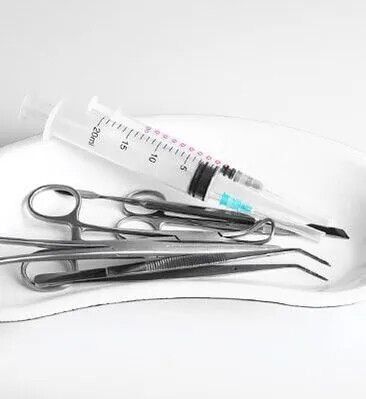Surgery
For severe or recurrent fungal nail infections, a surgical approach may be appropriate. Foot Foundation uses three different surgical procedures which are chosen on a case-by-case basis.
Surgical procedures may include removing the entire nail (total nail avulsion), removing a side of the nail (partial nail avulsion) or removing a small section of the nail (debridement).
Pairing a surgical treatment with topical, oral or laser treatment has higher success rates than surgery alone.
What do I need to know if I’ve been recommended to undergo surgery?
Surgical procedures are deemed minor and are performed in our clinical rooms at Angelsea Clinic. Only the part of nail that is diseased will be removed.
All three procedures are performed under local anaesthetic to prevent pain during the procedure. The clinician undertaking the procedure will loosen the skin surrounding the nail and separate the nail from the nail bed using specialist equipment.
You may wish to prevent the nail from growing back to guarantee the fungal infection is not able to reinfect the area. We can do this by destroying the nail matrix with a chemical called phenol which is applied to the cuticle after the affected nail has been removed.
Alternatively, you can allow the nail to re-grow. In this instance, we recommend a combination of fungal treatment to reduce any re-infection of the new nail. This approach is not guaranteed.
Following your procedure, the treated toe will be heavily bandaged and regular dressing changes will be required for two weeks until the wound site has healed. Your clinician will monitor your wound site closely over the following four weeks.
Who performs this procedure?
At Foot Foundation, our qualified podiatrist will perform nail surgery of the toenails.
If fingernail removal is required (which is much less likely), you will be referred to your GP or a specialist to have this procedure performed.
What are the risks involved?
Your clinician will outline in depth the risks involved with this procedure. However, the three main risks involved with this procedure are:
Pain
Infection – you can reduce the risk of infection by keeping the surgical site clean
Abnormal nail growth – when the nail grows back, it may grow back in an odd or thickened shape

How do I get diagnosed?
Your diagnosis takes place during a consultation with our Foot Foundation clinician. They will take a thorough medical history, consider your risk factors, complete a comprehensive physical examination and use a Diafactory fungal nail test to correctly diagnose your fungal infection. Diafactory fungal nail tests involve taking a clipping of your toenail, taking photos of your infected nails and measuring the line of fungal growth from the base of the nail so we can monitor your treatment over time.
Once a correct diagnosis has been made, your Foot Foundation clinician will discuss the most appropriate treatment protocol with you and answer any questions that you may have.
What is involved in the surgical treatment process?
If surgery is the right option for you, your podiatrist will take a comprehensive medical history to mitigate any potential risks involved with nail surgery.
The procedure will take place in Anglesea Clinic by a trained podiatrist. The procedure typically takes 60 - 90 minutes, depending on how many surgical sites are involved.
After your procedure, you will be given a surgical dressing pack with comprehensive instructions on how to look after your wound.
You will be required to see your podiatrist for the first two dressing changes. The podiatrist will examine the wound and provide clear instructions on aftercare until the wound is health.
Once your wound is healed, you will commence your recommended combination treatment and receive important information about appropriate hygiene and prevention protocols to reduce your re-infection rates during and after treatment. We are happy to answer any questions you may have.

